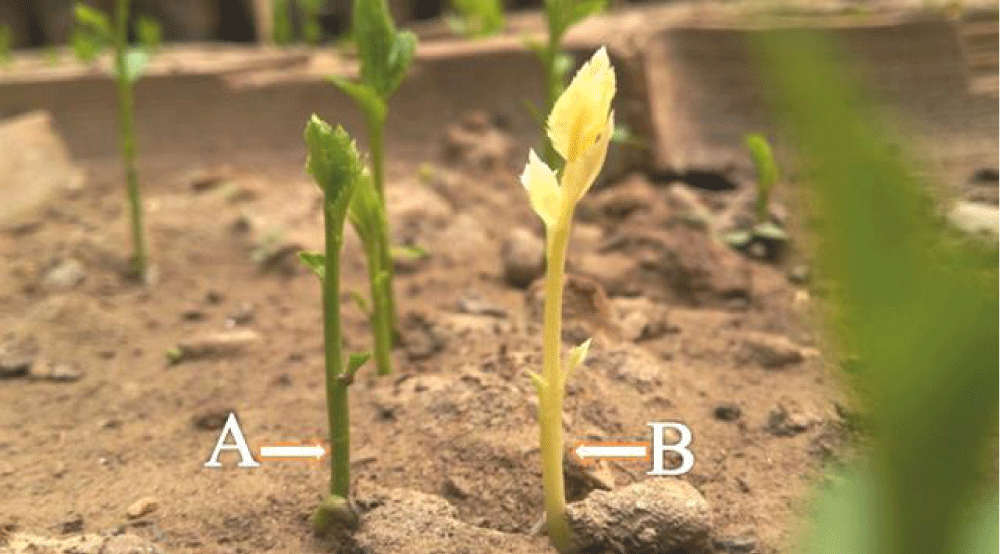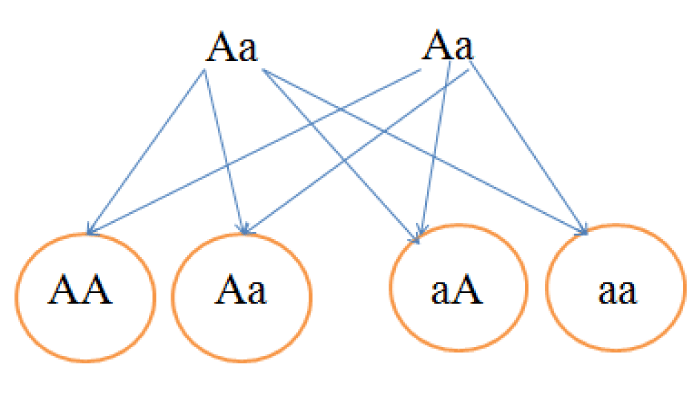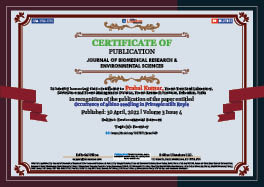Environmental Sciences . 2022 April 30;3(4):485-487. doi: 10.37871/jbres1469.
Occurrence of albino seedling in Prinsepia utilis Royle
Prabal Kumar1*, Devendra Kumar2 and Sanjay Singh3
2Extension Division, Forest Research Institute, Dehradun, India
3Biodiversity and Climate Change Division, Indian Council of Forest Research and Education, Dehardun, India
- Prinsepia utilis
- Bhekal
- Albinism
- Seedlings
- Chakrata
Abstract
Albinism in plants is characterized by partial or complete loss of chlorophyll pigments and incomplete differentiation of chloroplast membranes. This is a very common problem encountered in interspecific crosses and tissue culture experiments including anther culture and generation of doubled haploids. This impairs photosynthesis and the plants eventually die at a young stage without reaching maturity. Environmental conditions such as light, temperature, media composition and culture conditions may key factors in determining the frequency of albino plant formation. This short communication reports the first instance of albinism recorded in Prinsepia utilis Royle. An albino seedling was observed during the standardization of nursery techniques.
Introduction
Some wild plant species have the potential to enhance livelihood by providing alternatives to important raw material, thus bridging the gap between demand and supply. Wild plants have been used by traditional people since ages. Prinsepia utilis Royle one of them. Prinsepia utilis Royle (Family Rosaceae), commonly known as Bhekal. Bekhali, bekoi, Jhatlu etc. is a valuable edible wild species with immense economic value in the remote regions of Garhwal Himalaya [1]. It is a moderate-sized underutilized deciduous shrub widely distributed in the Himalayas at 1000-3000 msl., occurring frequently in open, sunny and dry places, rocky talus slopes, roadsides. In Deodar and Deodar mixed forest. It is also reported to colonies the degraded areas in Garhwal Himalayas [2]. The species could therefore be useful for reclamation of vast tracts of degraded hills in the Himalayas [3]. Geographically the whole genus of Prinsepia is confined primarily to continental eastern Asia. Its area of distribution ranges from western Pakistan and S.W. India to southern and central China, E. Magnolia, Russia, Manchuria and Korea [4]. Plant leaves are a very good source of fodder [5]. In past century plant is widely accepted among local people for its oil yielding seed kernel. Oil of this is species is a second major source of edible oil in the village of Urgain valley and contributed about 31% of total edible oil requirement. This amounts to annual utilization of 4076 litre, which is equivalent to Rs. 132048.00 (US $ 4260) per year. The total labour cost for oil extraction amounts to Rs. 55012.00 (US$ 1775) per year approximately. Thus, oil production provides a net profit of 77035.00 (US $ 2485)/year [1]. The oil has rubefacient properties, it is applied externally in for treatment of rheumatism and muscular pain resulting from fatigue [6]. The seed-cake paste is applied for the treatment of ringworm or eczema and hot oil cake provide relief in stomach aches [7]. The oil obtained from seeds is also suitable for biofuel [8].
Besides all these commercial, socio-economical, medicinal, and ecological values, this plant is also considered to be holy and used for worship, the twigs of the plants are used to offering in hawan-pooja in Jaunsar -Babar region. It is believed that this plant can keep away the evil spirits [9]. The plant bears white cream-colored flowers, which blooms through January to March, the fruiting in plant lasts from April to June. Fruit is single-seeded, oblong, berry’s, with fleshy edible Mesocarp. This paper reports the first instance of albinism recorded in this species. An albino seedling was observed during the standardization of nursery techniques.
Review of Literature
The term albinism derived from the Latin word “Albina” which means “white”. Albinism is defined as a lack of pigmentation, but it can take various forms depending on the severity of pigments loss as well as the nature of missing pigments. Habitat conditions such as available light, temperature, moisture and media may determine the frequency of albino plant formation [10]. Previous studies conducted on albino, occurrence in various forestry and agricultural species such as Bambusa arundinacea, oil palm, Eucalyptus, Zea mays, Artocarpus etc. reveal that the seeds are the main factor that contributes a lot. While referring to the reports and studies carried out the following salient point on albino formation in various species are noted. Albinism is governed by a single recessive gene and the trait is expressed only when it is in homozygous recessive (aa) condition [11]. Besides mutation, whether induced or spontaneous, albino seedlings may be produced either by selling of an albino carrier [12]. In both cases, the results may be depicted as follow.
where, A = Dominant, a = recessive
The phenotypic ration of 3:1 for pigmented and albino plants in Elaeis guinensisn (Nigerian oil palm) [13]. The albinism in oil palm is controlled by a single recessive gene, also [14] observed, albino Melocenna baccifera did not germinate naturally, but germinated to a fair degree when sown in large polybags. Few seedlings were albinos that grew to 60-75cm height and died within 1-2 months. Tests with fruits of Melocenna bambusoides gave one albino seedling which suggests that the trait is governed by a single recessive gene which may be the result of inbreeding. 400 seeds of Dendrocalamus strictus exhibiting 87% germination produced one albino seedling which did not survive beyond the 4-leaf stage [15] and concluded that the albinism in D. strictus is expressed by a single recessive gene. Several albino seedlings vary, depending on the extent of natural selfing, maturity of albino carriers, reduced population size, high degree of inbreeding reduction, heterozygosity and spontaneous mutation [16]. From 11 different red Mangrove trees of Rhizophora mangle, heterozygous for albinos were pigment fingerprinted by HPLC/diode array spectroscopy [17]. The majority of albino genotype were deficient in pigments of chlorophyll, xanthophylls and carotenes. Five different chemical phenotypes were distinguished. In red Mangroves, genetic load due to homozygosity for chlorophyll deficiency follows Muller’s mutation loci made by many different loci. The average load contribution is 1.3 × 10.4 homozygous albino offspring per locus. Albinism in animals occurs when an individual member of a species inherits a mutated gene from both parents that interferes with their body’s ability to produce melanin. When it comes to animals, the most obvious trait among those with albinism is pale white skin, hair, plumage, fur, scales, etc. The same mutation that affects the skin also affects the blood vessel pigments in the eyes, making them appear red or pinkish in color rather than white.
Work Carried Out and Observations
In the present study, mature and healthy seeds of P. utilis were collected from Chakrata Forest Division, Dehradun (30°41’32.69 N,77°52’ 19.39E) from different bushes based on altitudinal gradients (elevation 2216.01-3103, 1329.01-2216, 442-1329 msl) and experiment was carried out in Nursery at Forest Research Institute, Dehradun. The seeds were sown in nursery bed prepared with the mixture of soil, sand, and FYM, mixed in 1:1:1 ratio. The seeds were raised during May 2018. The germination of seeds commenced from 7 to 10 days after sowing. Out of 3600 sown, 2609 seeds germinated (72% germination) only 1 seedling (0.038%) were showed albinism. This seedling was marked for further study and comparison with a normal seedling. Albino seedling survived up to one month after germination with upward leaves and normal growth, after one month of growth, the plant started drooping, in the second month it was uprooted and compared with normal plant for the growth parameters (Table 1). This seed was collected from 1329 to 2216 m altitude (seed is identified with altitude only but not with the plant as the experiment was not pre-viewed earlier).
| Table 1: Number of seeds sown, germinated and albinos in Prinsepia utilis nursery raised in May 2018. | |||||
| Altitude (msl) | No. of seeds sown | No. of seeds germinated | Germination % | No. of albinos noticed | Albinos seedlings % |
| 2216.01-3103 | 400 | 372 | 93 | 0 | 0 |
| 1329.01-2216 | 2800 | 2092 | 91.75 | 1 | 0.047 |
| 442-1329 | 400 | 336 | 84 | 0 | 0 |
The average percentage of albinos worked out to 0.038%. Growth data of albinos from germination point (May 2018) to 18-6-2018 is given in table 2.
| Table 2: Data of albinos from germination point (May 2018) to 18-6-2018. | |||||
| Type of seedling | Shoot length | Root length | Collar diameter | No of leaves | Remark |
| Normal seedling | 10.5 | 8.9 | 1.45 | 8 | Normal growth and healthy |
| Albino | 5.6 | 7.0 | 1.64 | 6 | Abnormal growth and pale whitish |
This albino seedling stopped growing further from the second month after germination and now it was slowly getting withered to die as noticed in 2nd week of June.
Discussion
The occurrence of an albino seedling has been reported in this case study, which is the first report in this plant. Natural occurrence of albinos is rare among plant. The past researcher also reported this phenomenon from many other forestry and agricultural species, some of them are Pterocarpus santalinus [18], Azadirachta indica [19,20], Bombax ceiba [21], Tamarindus indica [22], Eucalyptus camaldulensis and E. terticornis [23], Slash pine [24]. Albino seedlings do not have any economic value. However, such mutant may be an important material for functional studies and may lead to gene discovery. According to Mendelian rule if the mother plant is heterozygous (Aa) it produces a greater number of albino offspring. In the present case, the exact reason for albinism is not known.
Conclusion
Though, such seedlings can be used as genetic markers for the estimation of natural selfing in a species. It is an important observation of breeder interest and further studies are required to ascertain the frequency of albino.
References
- Maikhuri RK. Prinsepia utilis (bhekl): A promising wild edible oil shrub of higher Himalaya-a case study in Urgain valley of Garhwal Himalaya. Plant genetic resources newsletter. 1995;1(14):115-123. https://tinyurl.com/3m3nsehd
- Maithani GP, Bhauguna VK, Negi JDS. Natural process in redeeming of Garhwal Himalayan wastelands. Indian Forester. 1986;112(7):608-615.
- Sarjan B, Singh O. Studies on determination of options sowing method of Prinsepia utilis royle seed in the fields. Indian Forester. 1991;117-119.
- Barnov A. Taxonomic study in the Genus Prinsepia (Rosaceae). Taiwania International Journal of Biodiversity. 1965;11(1):99-112.
- Nautiyal M, Tiwari P, Tiwari JK, Rawat DS. Fodder diversity, availability and utilization pattern in Garhwal Himalaya, Uttarakhand. Plant Archives. 2018;18(1):279-287. https://tinyurl.com/243mbw8z
- Chauhan NS. Medicinal and aromatic plant of Himachal Pradesh, Indus publishing company FS-5, Tagore Garden, New Delhi. 1999. https://tinyurl.com/mec6mwsv
- Manandhar NP. Plants and people of Nepal. Portland: Timber Press; 2002. 599.
- Thapliyal M, Tewari R, Bahar N. Oil seed of forest origin: Potential source of biofuel. Proceedings of 12th Silvicultural Conference. 2006;292-298.
- Sharma RL. Quality of life in the Himalayan region. Indus publishing company, FS-5, Tagore Garden, New Delhi. 2005;155.
- Kumari M, Clarke HJ, Small I, Siddique KHM. Albinism in plants: A major bottleneck in wide hybridization, androgenesis and doubled haploid culture. Critical Reviews in Plants Sciences. 2009;28:393-409. doi:10.1080/07352680903133252.
- Nagesh K, Reddy CS, Chandrnoli S, Rao PS. Albinism in Mundulera sericea (willd.) Chamel (Papilionaceae). Indian Forester. 2001;127(4):480-482.
- Dhiman RC, Sharma VK. Occurrence of Albino and other chlorophyll deficient seedlings in Dendrocalamus giganteus Munro. Indian Forester. 1997;123(5): 435-437.
- Kushairi A, Rao V, Rajanaidu N. A note on the inheritance of albinism in oil palm Elaeis. 1992;4(1):19-20.
- Dakshindus SD. Albino seedlings of Melocanna baccifera Roxb or M. Bambusodes In. Indian Forester. 1995;121(8):768-769.
- Kumar A, Sharma VK, Benwal BS. Albino seedlings in Dendrocalamu strictus Nees. Indian Forester. 1993;119(6):507-509.
- Gunaga RP, Wange SS, Mirgal AB, Rane AD, Narkhede SS, Bhave SG. A note on albinism in Saraka asoca (Roxb.) De wild. Indian Forester. 2013;139(5):471-472.
- Corredor JE, Morell JM, Klekowski EJJ, Lowenfeld R. Mangrove genetics. III. Pigment fingerprints of chlorophyll-deficient mutants. Int J. Pl. Sci. 1995;156(1). https://tinyurl.com/mtfdjsyp
- Vakshaya RK. Mutant albino in Red sanders. Silvae Genetica. 1981;80:163.
- Kulkarni HD, Srimathi RA. An albino type natural chlorophyll mutant in Azadirachta indica A.Silvae Genetica. 1987;36(1)45-46. https://tinyurl.com/yzhxcye6
- Dhillon RS, Hooda MS, Indu S, Pundeer JS. Albino mutants in Azadirachta indica (Neem), Pongamia pinnata (karanj) and Simmondsia chinensis (Jojoba). The Indian Forester. 2009;135(9):1287-1290.
- Venkatesh CS, Emmanuel CJSK. Spontaneous chlorophyll mutation in Bombax L. Silvae Genetica. 1979;25:137.
- Jaisankar I, Damodaran V, Singh DR, Sudha. Albinism in Tamarindus indica (L). Indian Forester. 2011;137(2):261-263.
- Venkatesh CS, Sharma VK. Some useful seedlings of Eucalyptus. Their genetic significance and value on breeding. Silvae Genetica. 1974;23:120-124.
- Squilace AL, Kraus JF. The degree of natural selfing in Slash pine as estimated from albino frequencies. Silvae Genetica. 1963;12.
Content Alerts
SignUp to our
Content alerts.
 This work is licensed under a Creative Commons Attribution 4.0 International License.
This work is licensed under a Creative Commons Attribution 4.0 International License.










